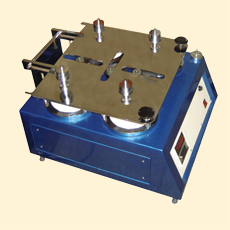-
 Determination of resistance of any
fabric to abrasion is usually carried out by abrading the fabric under
specified conditions against a standard abradant. Although plane abrasion of
fabric surface does not cover all aspects of strains that are important in
determining service life, there are occasions when such a test gives useful
information.
Determination of resistance of any
fabric to abrasion is usually carried out by abrading the fabric under
specified conditions against a standard abradant. Although plane abrasion of
fabric surface does not cover all aspects of strains that are important in
determining service life, there are occasions when such a test gives useful
information.
-
One of the standard equipment used
for this determination is the Martindale Abrasion Tester. This apparatus gives
a controlled amount of abrasion between fabric surfaces at comparatively low
pressures in continuously changing direction. Circular specimens of fabric are
abraded under known pressures under a motion which is the resultant of two
simple harmonic motions at right angle to each other. The resistance to
abrasion is estimated by visual appearance or by finding the loss in mass of
the specimens.
-
The PSI Martindale Abrasion
Tester consists of a plate which is give a motion combining two harmonic
motions at right angle through three rotating eccentric pegs, four number
specimen holders for mounting the fabric under test on, and four number abradent holders against which the test specimens are abraded.
-
The plate is supported on three
oil-lubricated felt discs and has three slots for locating the eccentric pegs
in. The pegs are rotated with the help of an electric motor, worm reduction
gearbox, and sprockets and chain arrangement such that the central peg is
rotating at a slower speed than the two outer pegs, which rotate at the same
speed. The movement of the pegs causes the plate to move in two mutually
perpendicular directions in simple harmonic motions, thus providing the
necessary abrading action.
-
The test specimens are mounted on
flat metallic discs and are backed with a thin layer of polyurethane foam. The
shafts of the specimen holders are guided vertically in bushes on the moving
plate. Thus the movement of the plate causes the specimen holders to move with
the plate, abrading it against the abradant fixed mounted in four holders
located below them. The force on the test specimens can be altered by adding
or removing dead weights from the specimen holders.
-
A five digit electronic pre-set
counter counts the number of rotation of outer pegs and stops the motor
automatically after a pre-set numbers of rotations. Templates for marking the
test specimens and abradant, disc weights to keep them flat during fixing, and
mounting jig for test specimens are provided as standard accessories.
-
The various components are mounted
on a sturdy fabricated steel base and are finished in grey hammertone stoving
painting and bright chrome or zinc plating to give them a corrosion resistant
finish.

